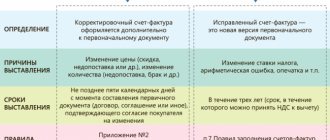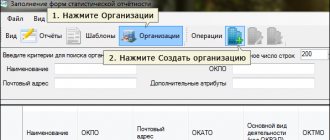Submitting reports to the tax office in 2021 for individual entrepreneurs using the simplified tax system
All owners of individual entrepreneurs, according to the legislation of the Russian Federation, are required to submit declarations to the Federal Tax Authority in a timely manner.
There are two options for submitting tax reports for individual entrepreneurs in 2018 according to the simplified tax system, these include:
- Payment of a tax fee of six percent.
- Payment of tax on income minus expenses in the amount of 15%.
Both forms are acceptable for a company with or without employees. The difference is that if there are employees, the owner of the company must send reports not only to the tax authority, but also to the Pension Fund of Russia, as well as the Social Insurance Fund.
Reporting on the simplified tax system requires regular registration of documents with data on income to the tax office.
Formation of documentation is allowed both in paper format and in electronic form. The first option must be sent to the authorized body in person or by letter, and the second can be sent via Internet channels.
Tax reporting deadlines in 2021
The simplest format for individual entrepreneurs is the absence of employees.
In this case, you only need to submit one report – a tax return. This report is compiled once every 12 months. The document reflects information at the end of the year: income and expenses.
Only one form is used to fill out, which does not change depending on the interest rate. The completed document must be submitted by the last day of April (until April 30, 2019).
When filling out the form, it is mandatory to take into account the income in the tax register. Sometimes expenses are recorded.
It is necessary to develop a register form and consolidate it in the tax accounting policy in advance if the individual entrepreneur uses a simplified taxation system. There is no need to prepare accounting reports using the simplified tax system, which greatly facilitates the activities of entrepreneurs.
When a company employs employees, it is necessary to submit reports not only to the tax service, but also to other authorized authorities.
The reporting of an individual entrepreneur working on the simplified tax system requires maintaining a book of expenses and income without fail. This point is clearly explained by Article 346.24 of the Tax Code of the Russian Federation.
If the organization employs at least one hired person, it is necessary to apply the reporting scheme below. Every year it is necessary to provide a certificate of the worker’s income, a declaration under the simplified tax system, as well as information about the number of personnel.
Quarterly, 6-NDFL, 4-FSS and documentation reflecting insurance premiums for the tax authority should be generated and calculated. Data are prepared on a monthly basis in the SZV-M form.
So, the deadlines for submitting reports of individual entrepreneurs on the simplified tax system in 2021 for a company with employees will be as follows:
Documents for the Social Insurance Fund
- 6-NDFL – until July 31, 2019 (from January to July) and until October 31, 2019 (for nine months).
- Tax return – until 04/30/2019.
- 2-NDFL – until 04/30/2019.
- 4-FSS (injuries) - in paper form until July 20, 2019 (January-June) and until October 22, 2019 (for nine months of 2021), in electronic form until July 25, 2019 (January-June) and until October 25 .2019 (for nine months of 2021).
- Calculation of insurance premiums – until 31.07. 2021 (January-June) and until October 31, 2019 (for nine months of 2021).
Documents for PF
SZV-M and SZV-STAZH until July 16, 2019 (for June 2018);
- Until August 15, 2019 (for July 2018).
- Until August 17, 2019 (for August 2018).
- Until October 15, 2019 (for September 2018).
- Until November 15, 2019 (for October 2018).
- Until December 17, 2019 (for November 2018).
Tax return for simplified tax system in 2021
Home / Tax returns
| Table of contents: 1. Place and deadline for submitting the declaration according to the simplified tax system 2. Methods of reporting 3. Declaration structure | 4. Instructions for filling out the simplified taxation system declaration 5. Fine for failure to submit a simplified taxation system declaration 6. Programs for preparing a report |
Declaration of the simplified tax system is an annual tax reporting that must be submitted by business entities applying the simplified taxation regime.
KND declaration form 1152017 was approved by order of the Federal Tax Service dated February 26, 2016 No. ММВ-7-3/ [email protected]
Download the declaration form
Sample declarations according to the simplified tax system: “income” or “income – expenses”
Sample zero declaration of the simplified tax system
Where to submit the declaration
Organizations submit reports at their location (legal address), individual entrepreneurs – at their place of residence.
At the same time, legal entities that have separate divisions include information on divisions in their declaration under the simplified tax system. There is no need to submit a separate report on the OP.
Deadlines for submitting a declaration under the simplified tax system
The tax period according to the simplified tax system is a calendar year. Reporting periods are: 1st quarter, half year, 9 months.
The declaration is submitted at the end of the tax period.
In this case, business entities submit reports within the following deadlines:
| Subject | Last day for filing a simplified tax return |
| Legal entity | March 31 of the year following the expired tax period |
| IP | April 30 of the year following the end of the tax period |
If the last day for filing a declaration falls on a weekend (holiday), then the deadline for submitting the report is postponed to the next working day. Thus:
- For 2021, legal entities must report by April 2 (inclusive) 2021, individual entrepreneurs - no later than 04/30/2021.
- For 2021: for companies - no later than April 1, 2021, individual entrepreneurs - no later than April 30, 2021.
If the taxpayer no longer meets the conditions for applying the simplified regime, reporting is submitted by the 25th day of the month following the reporting period in which the right to the simplified regime was lost.
A citizen closing an individual entrepreneur submits a report no later than the 25th day of the month following the month in which an entry was made about the termination of activities in the status of an individual entrepreneur in the Unified State Register of Individual Entrepreneurs or before the date of deregistration from tax registration (if these are the requirements of the local INFS).
When an organization is liquidated, a report on the simplified tax system is presented together with an interim or final liquidation balance sheet.
The date of submission of the report according to the simplified tax system is recognized as:
- When submitting to the tax authorities in person or through an authorized representative - date of filing;
- When sent through a post office - the date on the postal stamp;
- When transmitted via TCS channels (via the Internet) - the date specified in the confirmation of the EDF operator.
Reporting methods
You can submit a declaration in the following ways:
1) Printed out (filled out manually) on paper - in person, through an authorized person (with the obligatory presentation of a power of attorney: notarized - for a representative of an individual entrepreneur, ordinary - for a representative of a legal entity) or by post (with a list of attachments).
Tax reporting on paper is submitted:
- in 2 copies. – upon submission to the Federal Tax Service;
- in 1 copy. – when sent via Russian Post.
Note: some inspections accept a paper declaration only with a duplicate file attached on a flash drive.
2) Electronically via the Internet: directly on the Federal Tax Service website or through an EDF operator.
Declaration structure
Tax reporting under the simplified tax system includes:
- title page;
- section 1.1, which contains the amounts of the single tax according to the simplified tax system (advance tax payment) subject to payment (reduction) in connection with the use of the simplified regime (object “income”), based on information from the business entity;
- section 1.2, which records the amounts of the unified tax (advance) and the minimum tax payable (reduced) according to the simplified tax system (the object “income minus expenses”);
- section 2.1.1 – is intended for calculating the amount of the unified tax according to the simplified tax system “income”;
- section 2.1.2, which indicates the amount of the trade fee that reduces the EH under the simplified tax system “income”;
- section 2.2 – includes the calculation of the unified tax according to the simplified tax system “income minus expenses”;
- section 3 – data on funds received as part of targeted financing and charitable activities is reflected here.
The composition of the submitted declaration depends on the selected taxation object:
| Taxpayers | What sections are presented? |
| All organizations (IP), regardless of the object of taxation | Title page |
| Subjects who have chosen “income” as the object of the simplified tax system | Sections: 1.1; 2.1.1 and 2.1.2 (only if the organization (IP) is the payer of the trade tax) |
| Entities applying the simplified tax system “income minus expenses” | Sections: 1.2 and 2.2 |
| Subjects who received targeted funds, regardless of the object of taxation | Section 3 (usually not included in the declaration for commercial firms and individual entrepreneurs) |
In this case, the total indicators of section 2.1 (2.2) are first calculated and reflected, and then, based on these indicators, section 1.1 (1.2) is filled out.
It should be noted that only accrued tax amounts must be reflected in the sections of the declaration; paid tax amounts are not indicated in the report.
Instructions for filling out the simplified taxation system declaration
The procedure for filling out the declaration (hereinafter referred to as the Procedure) is contained in Appendix No. 3 to the Federal Tax Service order No. MMV-7-3 dated February 26, 2016 / [email protected]
General requirements
1. Amounts indicated in the declaration are rounded to whole rubles in accordance with the mathematical rules of rounding.
2. When filling out the declaration manually, it is allowed to use purple (black, blue) ink.
3. When preparing reports, it is prohibited:
- fasten sheets with a stapler;
- make corrections, including using white corrector or other means;
- Print report pages on both sides.
4. Pages are numbered in continuous order, regardless of the composition of the declaration, as follows: “001”, “002”, “003”, etc.
5. For each individual line of the report, a certain number of acquaintances is provided, and only one indicator is entered in one line.
To record decimal fractions (tax percentages), fields are provided, separated by a period symbol.
6. Numerical, text and code indicators are written into the form from left to right, from the leftmost cell. When using software to generate a report, the values of numerical indicators are aligned to the last right acquaintance.
7. Text information is written in the document fields in capital letters. If the document is filled out using software, Courier New font should be used (16 - 18 points high).
8. If after recording the indicator there are empty cells left in the line, dashes are placed in them (for example: the organization’s TIN is indicated in the following format: “1356785795–”).
9. If there are no indicators, empty lines are also crossed out. Moreover, if the reporting is prepared using software, then when printed there may be no cell boundaries and dashes in empty spaces.
10. Tax reporting generated through the software can be printed as a machine-readable form containing a two-dimensional barcode.
Title page
1. The data on the title page is filled out by the organization (IP), except for the block “To be filled out by an employee of the Federal Tax Service”.
2. INN/KPP. The corresponding codes are indicated. Individual entrepreneurs fill out only the TIN (a checkpoint code is not assigned to entrepreneurs).
3. Corrective report number. If reporting is submitted for the first time, you need to write down the code: “0–”. When submitting an updated declaration, the serial number of the adjustment is filled in: “1–”, “2–”, etc.
4. Taxable period. The period for which the report is submitted is indicated:
| Code | Period |
| 34 | Year |
| Last tax period: | |
| 50 | upon liquidation (reorganization) of an organization when closing an individual enterprise |
| 95 | when switching to another tax regime |
| 96 | upon termination of business activity when closing activities on the simplified tax system |
5. Reporting year. The year for which the declaration is submitted is completed.
6. Inspection code. The four-digit code of the inspection to which the document is being submitted is filled in.
7. Code at the place of registration. The code for the place of presentation of the document is indicated:
| Code | Name |
| 120 | At the place of residence of the individual entrepreneur |
| 210 | At the location of the Russian legal entity |
| 215 | At the location of the legal successor who is not one of the largest taxpayers |
8. Below, fill in the full name of the legal entity or full name of the individual entrepreneur (line by line).
9. Then the OKVED code from the OKVED2 classifier is entered.
10. Liquidation (reorganization) code and TIN/KPP of the liquidated (reorganized) legal entity. These fields are filled in only in cases of liquidation (reorganization) of a legal entity in accordance with Appendix No. 3 to the Procedure:
| Code | Name |
| 1 | Conversion |
| 2 | Merger |
| 3 | Separation |
| 5 | Accession |
| 6 | Division with simultaneous accession |
| 0 | Liquidation |
11. Next, indicate the taxpayer’s contact phone number.
12. The number of pages of the submitted reporting and the number of pages of annexes to the declaration are indicated.
13. Field “Confirmation of information accuracy”. The code of the individual submitting tax reporting is entered:
- 1 – if the taxpayer submits the declaration;
- 2 – if the document is transmitted through an authorized representative.
The fields Full name, signature, date are filled in in the following order:
| Who submits the declaration | What data is indicated? |
| IP | signs and puts down the date of signing the declaration, does not fill in the full name |
| Organization | The full name of the head of the legal entity is filled in, dated and signed |
| Representative – individual | indicate the name of the representative, date and signature; below, fill in the details of the power of attorney or other document confirming the authority of the representative |
| Representative – legal entity | First, the full name of the authorized person of the representative company is indicated, then the name of the representative company itself is entered, the signature, date and details of the confirming document on the authority of the individual submitting the report are put |
Note: if an individual does not sign the declaration, but simply submits it to the Federal Tax Service on behalf of the entity, the full name of such person does not need to be indicated on the title page.
Section 2.1.1
This section is drawn up only by business entities using the simplified tax system “income”.
| Line code | Content |
| 102 | You should indicate the payer's attribute: “1” – for an organization (IP) that makes payments of remuneration to individuals; “2” – for individual entrepreneurs without employees |
| 110-113 | The amounts of income received by the taxpayer are recorded on an accrual basis for the 1st quarter, half year, 9 months, and year. The procedure for determining income is approved in Art. 346.15 Tax Code of the Russian Federation. If the declaration is submitted in connection with the termination of activity or loss of the right to the simplified tax system (before the end of the tax period), the indicator for the last working reporting period (reflected in lines: 110, 111, 112) is duplicated on line 113. |
| 120-123 | The tax rate is indicated as a percentage, line by line: for 1 quarter, half a year, 9 months, a year. When submitting a declaration before the end of the calendar year, the tax rate indicated for the last period of business (from lines: 120, 121, 122) is duplicated on line 123. |
| 130-133 | Advance payments for the Unified National Tax and the amount of tax for the calendar year are reflected according to the following formulas: |
| 130 | Line 130 = line 110 * line 120 / 100 |
| 131 | Line 131 = line 111 * line 121 / 100 |
| 132 | Line 132 = line 112 * line 122 / 100 |
| 133 | Line 133 = line 113 * line 123 / 100. When submitting reports before the end of the year, the value of the indicator for the last working reporting period (from lines: 130, 131, 132) is repeated on line 133. |
| 140-143 | Filled in with a cumulative total of the amounts of insurance premiums and benefits paid to hired personnel (in accordance with clause 3.1 of Article 346.21), by which the subject has the right to reduce the amount of advances for the unified tax (single tax amount) accrued for the reporting (tax) period. At the same time, taxpayers who indicated on line 102: “1” – they can reduce the amount of advances for the Unified National Tax (tax) by no more than 50%, i.e. the indicators of lines 140-143 cannot be more than 1/2 of the indicators of lines 130-133, respectively; “2” – they can reduce the amount of advances for the unified tax (tax) by the entire amount of contributions paid, while the indicators of lines 140-143 should not exceed the indicators of lines 130-133. When submitting reports before the end of the year, the value of the indicator for the last working reporting period (from lines: 140, 141, 142) is repeated on line 143. |
Section 2.1.2
This section is formed only by entities that apply the simplified tax system “income” and are payers of the trade tax.
The need for a separate section is due to the fact that the amount of the trade fee can only be deducted from income received from activities that are directly subject to this fee.
Consequently, if the taxpayer has types of activities that do not fall under the trade tax, then income from them is not included in this section.
The section consists of two sheets.
The first sheet is filled out similarly to section 2.1.1:
| Line code | Content |
| 110-113 | Fill in with a cumulative total (line by line: for 1 quarter, half a year, 9 months and a year) of the amount of income from activities subject to trade tax. If the subject does not conduct any other type of activity other than trade, the data in lines 110-113 of section 2.1.1 is duplicated |
| 130-133 | The amount of the advance payment for the Unified Tax (tax amount) is calculated: |
| 130 | Line 130 = line 110 * line 120 of section 2.1.1 / 100 |
| 131 | Line 131 = line 111 * line 121 of section 2.1.1 / 100 |
| 132 | Line 132 = line 112 * line 122 of section 2.1.1 / 100 |
| 133 | Line 133 = line 113 * line 123 of section 2.1.1 / 100 |
| 140-143 | The amounts of insurance payments (only for employees engaged in trading activities) are indicated as a cumulative total, reducing advances for the unified social security (tax), in accordance with clause 3.1 of Art. 346.21 If the organization (IP) does not conduct other activities other than trade, the information reflected in lines 140-143 of section 2.1.1 is duplicated In this case, the procedure for filling out lines 140-143 of section 2.1.2. (depending on the taxpayer’s characteristics) fully complies with the procedure for filling out lines 140-143 of section 2.1.1 |
The second sheet of the section is formed in the following order:
| Line code | Content |
| 150-153 | Filled in with a cumulative total of the amount of trade tax that the taxpayer actually paid during the tax (reporting) period |
| 160-163 | The collection amounts by which the amounts of advance payments for the Unified Tax (tax) can be reduced are indicated. The trade fee can reduce the accrued advances under EN (tax) to zero. In order to calculate the amount of the fee that reduces the tax, you need to subtract the corresponding indicators of lines 140-143 from the indicators of lines 130-133, while:
|
Section 1.1
Filled out only by taxpayers using the simplified tax system “income”. It is formed on the basis of the data reflected in sections 2.1.1 and 2.1.2.
| Line code | Content |
| 010, 030, 060, 090 | The OKTMO location of registration of a legal entity or place of residence of an individual entrepreneur is indicated. If the OKTMO code has not changed during the calendar year, it is enough to fill in only line 010. The remaining lines are filled with dashes. If OKTMO consists of 8 characters, then the remaining three cells are also crossed out (for example: “25896374—”) |
| 020 | Fill in the amount of the advance payment for the unified tax due no later than April 25 of the reporting year. To calculate the advance amount, the data in sections 2.1.1 and 2.1.2 are used. If the business entity is not a payer of the trade tax: Line 020 = line 130 of section 2.1.1 – line 140 of section 2.1.1. If the taxpayer pays a trade tax: Line 020 = section 2.1.1 line 130 – section 2.1.1 line 140 – section 2.1.2 line 160 This indicator is indicated if its value is ≥ 0. |
| 040 | Fill in the amount of the advance payment for the unified tax due no later than July 25 of the reporting year. In this case, entities that do not pay the trade fee calculate this indicator as follows: Line 040 = (line 131 – line 141) section 2.1.1 – line 020, Fee payers make calculations using a different formula: Line 040 = (line 131 – line 141) of section 2.1.1 – line 161 of section 2.1.2 – line 020. This indicator is filled in if its value is ≥ 0. When the result of the calculation is negative, it is reflected as a tax to be reduced (on line 050), and not to be paid. In this case, the indicator is written in line 050 without the minus sign |
| 050 | The amount of the advance payment for the Unified National Tax is indicated for reduction no later than July 25 of the reporting year. |
| 070 | Fill in the amount of the advance payment for the unified tax no later than October 25 of the reporting year. Calculation for non-payers of the fee: Line 070 = (line 132 - line 142) section 2.1.1 - line 020 - line 040 + line 050. Calculation for fee payers: Line 070 = (line 132 – line 142) of section 2.1.1 – line 162 of section 2.1.2 – line 020 – line 040 + line 050. When the calculation result is negative, it is transferred to line 080. |
| 080 | The amount of the advance payment for the unified tax is indicated for reduction no later than October 25 of the reporting year |
| 100 | The amount of EUR to be paid additionally for the calendar year is reflected, taking into account previously accrued advance payments. For non-payers: Line 100 = (line 133 – line 143) of section 2.1.1 – line 020 – line 040 + line 050 – line 070 + line 080. For fee payers: Line 100 = (line 133 – line 143) of section 2.1.1 – line 163 of section 2.1.2 – line 020 – line 040 + line 050 – line 070 + line 080. When the calculation result is negative, it is reflected on line 110. Note: according to the letter of the Federal Tax Service dated June 29, 2017 No. SD-4-3/ [email protected] , before changes are made to the current simplified taxation tax declaration form, entrepreneurs applying the simplified tax system (income) + PSN and who have lost the right to PSN during the tax period, reduce the amount tax on line 100 on the cost of the patent. |
| 110 | The amount of EUR to be reduced for the tax period is indicated. |
Section 2.2
Formed by business entities using the simplified tax system “income minus expenses”.
| Line code | Content |
| 210-213 | The amounts of income received by the entity for the 1st quarter, half year, 9 months, year are recorded as a cumulative total. Income is determined in accordance with Art. 346.15 Tax Code of the Russian Federation. If the declaration is submitted in connection with the termination of activity or loss of the right to the simplified tax system (before the end of the tax period), the amount of income indicated for the last period of activity (from lines: 210, 211, 212) is duplicated on line 213 |
| 220-223 | Indicated as a cumulative total of the amount of expenses that were incurred by the entity for the 1st quarter, half year, 9 months, year. The procedure for determining expenses is approved in Art. 346.16 Tax Code of the Russian Federation. When submitting a declaration before the end of the calendar year, the amount of expenses indicated for the last period of business (from lines: 220, 221, 222) is duplicated on line 223 |
| 230 | Fill in the amount of loss received in previous years by which the tax base for the tax period can be reduced |
| 240-243 | The tax base is calculated and reflected as the difference between income received and expenses incurred: |
| 240 | Line 240 = line 210 – line 220, Moreover, if the calculation result is negative, it is transferred to line 250 without the minus sign |
| 241 | Line 241 = line 211 – line 221, if total < 0, then → line 251 |
| 242 | Line 242 = line 212 – line 222, if total < 0, then → line 252 |
| 243 | Line 243 = line 213 – line 223 – line 230, if the total is < 0, then → line 253. When filing a declaration before the end of the calendar year, the value of line 243 will be equal to the tax base indicated for the last period of business (from lines: 240, 241 , 242) minus the loss from line 230 |
| 250-253 | Fill in the amount of losses received for the 1st quarter, half year, 9 months. and year |
| 260-263 | Tax rates for the 1st quarter, half-year, 9 months, and year, established by the legislative acts of the region in which the taxpayer operates under a simplified regime, are indicated line by line. When filing a declaration before the end of the calendar year, the tax rate indicated for the last period of business (from lines: 260, 261, 262) is duplicated on line 263 |
| 270-273 | Advance payments for the Unified National Tax and the amount of tax for the calendar year are reflected using the following formulas (if losses were incurred at the end of the reporting or tax periods, these indicators are not filled in): |
| 270 | Line 270 = line 240 * line 260 / 100 |
| 271 | Line 271 = line 241 * line 261 / 100 |
| 272 | Line 272 = line 242 * line 262 / 100 |
| 273 | Line 273 = line 243 * line 263 / 100. When submitting a declaration before the end of the year, the value of the indicator indicated for the last period of business (from lines: 270, 271, 272) is duplicated on line 273 |
| 280 | The amount of the minimum tax calculated for the tax period is entered: Line 280 = line 213 * 1/100. This line of the report must be completed, even if the taxpayer does not have to pay the minimum tax at the end of the calendar year |
Section 1.2
This section is filled out by payers using the simplified tax system with the object of taxation “income reduced by expenses.”
The section is formed on the basis of the information reflected in section 2.2.
| Line code | Content |
| 010, 030, 060, 090 | The OKTMO code of the location of the legal entity or the place of residence of the individual entrepreneur is indicated. If the OKTMO code has not changed during the tax period, you only need to fill in line 010. The remaining lines are filled with dashes. If OKTMO consists of 8 characters, then the remaining three cells are also crossed out (for example: “25896374—”) |
| 020 | Fill in the amount of the advance payment for the unified tax due no later than April 25 of the reporting year. Line 020 = line 270 of section 2.2 |
| 040 | The amount of the advance payment for the Unified National Tax is recorded no later than July 25 of the reporting year. Line 040 = line 271 of section 2.2 – line 020, This indicator is filled in if its value is ≥ 0. When the result of the calculation is negative, it is reflected as a tax to be reduced (on line 050), and not to be paid. In this case, the indicator is written in line 050 without the minus sign |
| 050 | The amount of the advance payment for the Unified National Tax is indicated for reduction no later than July 25 of the reporting year. |
| 070 | Fill in the amount of the advance payment for the unified tax no later than October 25 of the reporting year. Line 070 = line 272 of section 2.2 – line 020 – line 040 + line 050, if total < 0, then → line 080 |
| 080 | The amount of the advance payment for the unified tax is indicated for reduction no later than October 25 of the reporting year |
| 100 | The amount of EUR to be paid additionally for the calendar year is reflected, taking into account previously accrued advance payments. Line 100 = line 273 of section 2.2 – line 020 – line 040 + line 050 – line 070 + line 080. This indicator is filled in if the total ≥ 0 and line 273 of section 2.2 ≥ line 280 of section 2.2, if the total < 0, then → line 110 Note: according to the letter of the Federal Tax Service dated June 29, 2017 No. SD-4-3/ [email protected] , before changes are made to the current simplified tax return form, entrepreneurs applying the simplified tax system (income minus expenses) + PSN and who have lost the right to PSN during the tax period, reduce the amount of tax on line 100 by the cost of the patent. |
| 110 | The amount of EUR to be reduced for the tax period is indicated. |
| 120 | Fill in the amount of the minimum tax payable for the tax period. This indicator is formed if line 280 of section 2.2 > line 273 of section 2.2. Line 120 = line 280 of section 2.2 – line 020 – line 040 + line 050 – line 070 + line 080. If the total < 0, then → line 110. This means that the taxpayer offsets the advances paid under the unified tax against the minimum tax. In this case, an application for offset is submitted to the inspectorate, accompanied by copies of payment orders for advances paid. |
Section 3
This section is completed only by those taxpayers who received targeted funds (with the exception of subsidies issued to autonomous institutions).
Types of targeted financing are approved in clauses 1, 2 of Art. 251 Tax Code of the Russian Federation.
This section contains information from Section 3 of the previous tax period about unspent target funds, the period of use of which has not yet expired, as well as about funds for which the period of use has not been established.
| Column number | Content |
| 1 | The code of the type of receipts from Appendix No. 5 to the Procedure is recorded |
| 2 / 5 | The date of receipt of the target funds and the period for their use established by the transferring party are indicated. If the period for using targeted funding is not set, these columns are not filled in |
| 3 / 6 | The amount of target funds received in expired tax periods, the period of use of which has not yet expired, is recorded, as well as the amount of funds received in previous periods, for which the period of use was not initially established. |
| 4 / 7 | The amount of funds used on time for the intended purpose is indicated, as well as the amount of funds not used on time or spent for other purposes. Receipts reflected in column 7 are subject to inclusion in non-operating income at the moment when the recipient did not use them for the intended purpose. |
Below, in the “Report Total” line, the total indicators for columns 3, 4, 6, 7 are reflected.
Penalty for failure to submit a simplified taxation system declaration
If a business entity does not submit a declaration on time, then the sanctions will range from 5% to 30% of the amount of unpaid tax reflected in the reporting for each full or partial month of delay, but not less than 1,000 rubles.
Moreover, if the single tax itself is paid on time, then failure to submit a declaration within the prescribed period will result in a fine of 1,000 rubles. Responsibility for a delay in a report under the simplified tax system imposed on the head of a legal entity of the Code of Administrative Offenses of the Russian Federation can range from 300 to 500 rubles.
In addition, if the deadline for submitting a declaration is exceeded by more than 10 working days, the Federal Tax Service has the right to suspend operations on the taxpayer’s current account.
Report preparation programs
A declaration under the simplified tax system can be prepared using the following software:
| Software name | Website |
| "Taxpayer Legal Entity" | https://www.nalog.ru/rn77/program/5961229/ |
| "Bukhsoft" | https://www.buhsoft.ru/download/ |
| "1C" | 1c.ru |
| "Kontur-Elba" | https://e-kontur.ru/landing_usn/ |
| "Kontur.Accounting" | https://www.b-kontur.ru/lp/usn |
| "Sky" | nebopro.ru |
| "Taxpayer PRO" | https://nalogypro.ru/nalogovaya-otchetnost/usn/ |
| "My business" | https://www.moedelo.org/landingpage/reporting-usn/ |
Read in more detail: Changes to the simplified tax system from January 1
Did you like the article? Share on social media networks:
- Related Posts
- Sample of filling out the simplified taxation system “income” declaration
- Zero declaration of the simplified tax system in 2021
- Explanatory note to the tax return for UTII
- Sample of filling out the Unified Agricultural Tax declaration for an LLC
- Sample of filling out a UTII declaration for an LLC
- Tax return UTII
- Tax return of the Unified Agricultural Tax
- Sample declaration of the simplified tax system “income minus expenses”
Leave a comment Cancel reply
Tax reporting forms in 2021
New structure of document 4-FSS. Speaking about reporting forms in 2021, you should pay special attention to the changes that relate to the structure of the 4-FSS calculation. This document is provided by employers to the Social Insurance Fund when making contributions for injuries.
Reporting for 9 months, starting from 2021, will be filled out taking into account the updated version (FSS order No. 275 of June 7, 2017).
According to the legislation, the following information has been added to the new form:
- An additional line has been added to the title page to indicate the level of budget from which the employer receives funding if he operates as a budgetary enterprise.
- An additional line (1.1.) has been added to table No. 2 to record data on arrears in contributions of policyholders who have undergone reorganization or on debts of divisions of companies deregistered with the Social Insurance Fund.
- A line (14.1) has been added to table No. 2 to record debts of the Social Insurance Fund to the policyholder or deregistered divisions of the company.
Taking into account all the changes, the following adjustments have been made:
- The data from line No. 8 (formula) is now reflected in line 1.1.
- The data in line No. 8 (formula) is now reflected in line 14.1.
Adjustments were made to the order in which the calculation was completed. The procedure itself was supplemented with the following provisions:
- Period for calculating the average number of staff.
- Written off debt.
Useful material : Agreement between individual entrepreneur and individual entrepreneur. Sample document.
General filling rules
When filling out the annual financial report forms, you must adhere to the following rules:
- All fields must be filled out in Russian only.
- All amounts are reflected in rubles.
- Total indicators are reflected depending on the turnover in thousands or millions of rubles without decimal places.
- Numerical indicators are indicated minus regulatory values, that is, in a net assessment.
- If there is no indicator in some fields, a dash is added. Reporting documents should not contain empty fields.
- Corrections and blots are not allowed.
- Indicators that are subtracted or negative values are indicated in parentheses.
- The assessment of report items is carried out in accordance with the rules established by the PBU.
- Offsetting assets and liabilities in the balance sheet and profit and loss in the income statement is not allowed.
- Data should be comparable with similar indicators of previous years.
- The report is signed by the head of the organization. The signature of the chief accountant is not required.
Updates to statistical reporting
The innovations also affected statistical reporting. According to Rosstat Order No. 566 dated September 1, 2021, the following reporting forms were introduced:
- 1-T records data on staff size and wages.
- 1-T (working conditions) reflects information about working conditions and the calculation of required compensation in connection with these conditions.
- 1-T (GMS) reflects the size of the staff and income in municipal and government agencies.
- 2-GS (GZ) records information on additional education of federal employees.
- 2-MS reflects additional education of municipal employees.
To generate reports on a monthly basis, starting from February 1, 2021, use:
- 1-3 reflects information about the workforce.
- 3-F records information about overdue wage payments.
- 1-PR contains information about suspension of work due to strikes.
- P-4 reflects state data and earnings.
- P-4 (NZ) records information about underemployment of workers.
It is worth noting that more than a hundred reports on various types of grounds can be sent to Rosstat. Each business entity must constantly monitor innovations in statistical forms.
Now it’s worth talking about the innovations that are planned in the near future, assuming that in 2021 they will acquire legal force.
What is new to expect when filling out the 3-NDFL declaration?
Today, 3-NDFL is filled out according to the form that was introduced by order of the Federal Tax Service on December 24, 2014.
Presumably, adjustments will be made to the legislative act in accordance with the provisions of the draft dated May 11, 2017 No. 02/08/05-17/00065969. Today the project is at the adoption stage.
Changes will be made to the following points:
- The order of data presentation (sheet E).
- The procedure for providing information (sheet 3) regarding deductions within securities.
- Lines about data on real estate, upon the sale of which there is a need to pay personal income tax, will be added to sheet K.
It is likely that amendments will be made to the order related to updated provisions on the procedure for filling out the declaration. The changes will also affect document barcodes.
Interesting material: Increase in personal income tax in 2018 for individuals.
Tax reporting - new forms
Representatives of the Federal Tax Service systematically make amendments to existing fiscal regulations. Changes in legislation require bringing unified reporting forms into compliance. Consequently, updating of unified reporting documents and rules for their preparation is carried out with a fairly high frequency.
In 2021, changes affected declarations and calculations for VAT and income tax. However, it is worth noting that new reporting forms for these taxes have not been approved in 2021. Only the rules for filling them out have changed.
Thus, the income tax return remained the same. The form was approved by Order of the Federal Tax Service of Russia dated October 19, 2016 No. ММВ-7-3/ [email protected] But from January 1, 2018, when filling out the ND, a new procedure should be applied. Changes have occurred in terms of clarifying the composition of non-taxable income of economic entities, the procedure for reflecting R&D costs has been adjusted, the list of bad debts has been expanded, and the algorithm for applying increasing factors when calculating depreciation has been clarified.
The changes also affected VAT declarations. We use the old form (approved by Order of the Federal Tax Service dated October 29, 2014 No. MMV-7-3/ [email protected] as amended by Order dated December 20, 2016 No. MMV-7-3/ [email protected] ). But we apply new filling rules. Officials have adjusted the list of transactions that are exempt from taxation. Innovations also affected the tax-free system introduced for foreigners.
The UTII declaration is only awaiting changes. This is due to the provision of a new tax deduction for individual entrepreneurs on UTII for the purchase of online cash registers. Tax authorities are late in approving the new reporting form in 2021. For now, you should provide the old form approved by Order of the Federal Tax Service of Russia dated July 4, 2014 No. ММВ-7-3/ [email protected] (as amended by Order of the Federal Tax Service of Russia dated October 19, 2016 No. ММВ-7-3/ [email protected] ).
For income received in 2021, citizens had to report under the new 3-NDFL declaration. The form was adjusted by Order of the Federal Tax Service of Russia dated October 25, 2017 No. ММВ-7-11/ [email protected] The changes affected the barcodes on the report pages, the fields of the title page and some other sheets (D1, E1, Z) were changed. The tax authorities also added a new appendix to the declaration: “Calculation of income from the sale of real estate.”
Tax officials also adjusted property tax returns. Thus, the new ND on the property tax of organizations was approved by Order of the Federal Tax Service dated March 31, 2017 No. ММВ-7-21/ [email protected] (section 2.1 added). ND for land tax was adjusted by Order No. ММВ-7-21/118 dated 03/02/2018. The transport tax declaration was amended by Order of the Federal Tax Service dated December 5, 2016 No. ММВ-7-21/ [email protected]
Changes in financial statements submitted to Rosstat
All forms of reporting provided, as well as deadlines for submitting documents, remain unchanged in 2021.
However, it is worth paying attention to the fact that innovations are expected in determining the addressee of this documentation. At the moment, financial statements are submitted to Rosstat and the Federal Tax Service.
In accordance with the bill dated March 6, 2017 No. 02/04/03-17/00062756, it is assumed:
- Cancellation of submission of financial statements to the statistical authority.
- Formation of a unified information base for processing documents in the Federal Tax Service. Data from this database can only be requested for a fee.
- The ability for business entities to submit reports at their own discretion: both in paper form and in electronic form (or simultaneously in both). In this case, the reporting company must be ready to submit a paper version of the reporting to the Federal Tax Service upon request.
We recommend material: Documents for closing an individual entrepreneur in 2021.









